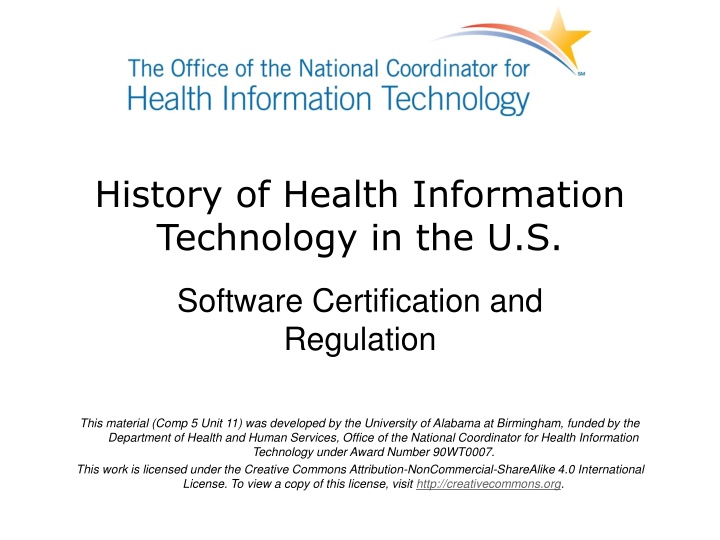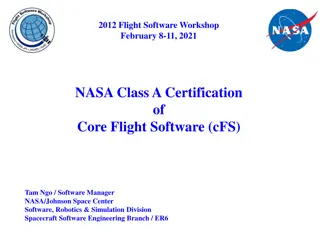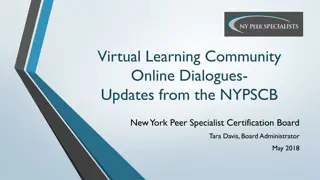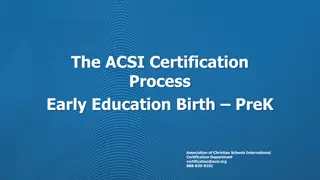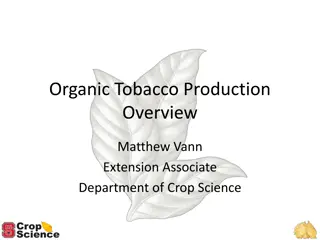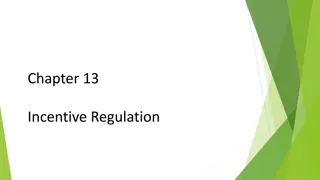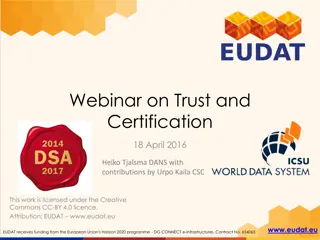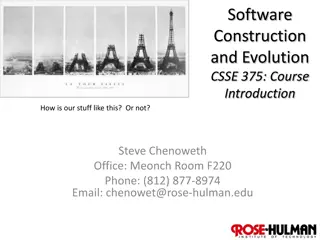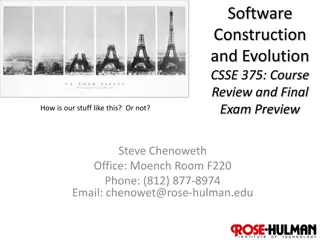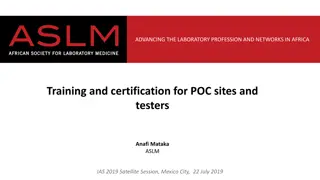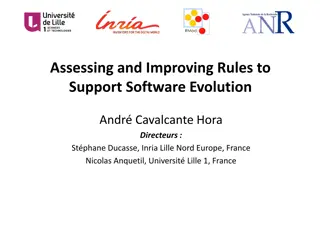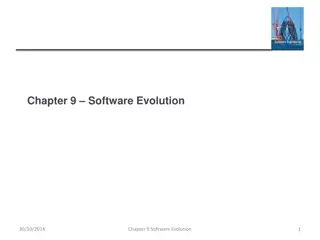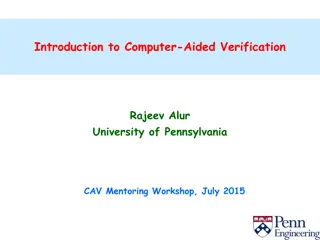Evolution of Health Information Technology Software Certification and Regulation
Explore the history of FDA involvement in clinical software regulation, the role of CCHIT, changes in EHR certification due to the HITECH Act, and recent efforts to enhance EHR safety. Learn about certification processes, FDA's role in regulation, challenges faced, and the importance of human intervention in early regulatory attempts.
Download Presentation

Please find below an Image/Link to download the presentation.
The content on the website is provided AS IS for your information and personal use only. It may not be sold, licensed, or shared on other websites without obtaining consent from the author.If you encounter any issues during the download, it is possible that the publisher has removed the file from their server.
You are allowed to download the files provided on this website for personal or commercial use, subject to the condition that they are used lawfully. All files are the property of their respective owners.
The content on the website is provided AS IS for your information and personal use only. It may not be sold, licensed, or shared on other websites without obtaining consent from the author.
E N D
Presentation Transcript
History of Health Information Technology in the U.S. Software Certification and Regulation This material (Comp 5 Unit 11) was developed by the University of Alabama at Birmingham, funded by the Department of Health and Human Services, Office of the National Coordinator for Health Information Technology under Award Number 90WT0007. This work is licensed under the Creative Commons Attribution-NonCommercial-ShareAlike 4.0 International License. To view a copy of this license, visit http://creativecommons.org.
Software Certification and Regulation Learning Objectives Discuss the history of FDA involvement in the regulation of clinical software Describe the origins, focus and activities of CCHIT Discuss the changes in the EHR certification process as a result of the HITECH Act Discuss the recent efforts to improve the safety of EHRs 2
Certification and Regulation Food and Drug Administration (FDA)
Certification and Regulation 2 Certification Functionality Individual EHRs 4
Certification and Regulation 3 FDA Center for Devices and Radiological Health (CDRH) Embedded software Accessory software for regulated device Stand-alone software 5
Certification and Regulation 4 Pre-market Review Design Manufacturing practices Testing Post-market Review Problems 6
Certification and Regulation 5 Challenges Difficult to test in advance Interaction with other systems Problems have multiple causes 7
Certification and Regulation 6 Does not guarantee Safe implementation Usability Outcomes 8
Early Attempts at Regulation Principle of competent human intervention (learned intermediary) FDA draft rule 1989 Source: (Manning, 1996) 9
Early Attempts at Regulation 2 FDA Workshop 1996 Stand-alone software systems Clinical decision support Closed and open loop systems Recommendations Risk Classification Software Quality Audits Source: (Manning, 1996) 10
1997 Professional Organization Recommendations Articles published in two journals JAMIA for informatics professionals Annals of Internal Medicine for physicians and health professionals Sources: (Miller & Gardner, JAMIA, 1997) (Miller & Gardner, Ann Intern Med, 1997) 11
1997 Professional Organization Recommendations 2 FDA focus should be: High risk systems Systems with limited opportunity for competent human intervention Good manufacturing/design practices Software monitoring at local level 12
1999 Institute of Medicine Report To Err is Human Focus on Patient Safety Information Technology as mechanism to IMPROVE safety Photo by Nir Menachemi 13
Growing Interest in Health Information Technology Additional Institute of Medicine reports Crossing the Quality Chasm 2001 Patient Safety 2004 Preventing Medication Errors 2006 Source: (Quality Chasm Series, 2001) 14
Growing Interest in Health Information Technology 2 Leapfrog Group 2000 CPOE to reduce medication errors 15
Growing Interest in Health Information Technology 3 Office of the National Coordinator 2004 Certification Commission for Health Information Technology (CCHIT) 2004 16
Certification Commission for Health Information Technology Non-profit private organization Formed by three bodies representing the IT community in 2004 AHIMA, HIMSS, and NAHIT 17
Certification Commission for Health Information Technology 2 Contract to develop criteria 2006 EHR certification body 2006 Single systems Inpatient and outpatient 18
Research, HIT and Patient Safety Research directions HIT can improve patient safety o CPOE o Clinical Decision Support 19
Research, HIT and Patient Safety 2 HIT can cause unintended consequences o Ash and colleagues CPOE and negative reactions Other problems o Koppel and colleagues JAMA 2005 Safety concerns Sources: (Ash, et al., 2009) (Koppel, et al., 2005) 20
HITECH Act 2009 Incentives for meaningful use of EHRs Anticipate increase in EHR adoption Certifying bodies for EHRs 21
HITECH Act 2 Increased concern about safety and need for regulation Congressional hearings FDA reviewing policies 22
ONC Authorized Testing and Certification Bodies Organizations apply to ONC to become certification bodies 2010 ATCBs 2012 ATLs and ACBs o Separate testing and certification 23
Institute of Medicine Consensus Study Plan to study risks of health IT and make recommendations on risk management Greater transparency Source: (Institute of Medicine, 2011) Courtesy National Academies Press 24
Institute of Medicine Consensus Study 2 Plan to study risks of health IT and make recommendations on risk management Greater transparency Criteria to assess and monitor safe use of health IT Public reporting of adverse events Agency to investigate serious problems If insufficient progress, FDA may regulate More research on better designs 25
Usability and Certification NIST Usability guidelines 2014 certification criteria Safety-enhanced design o User-centered design CPOE, CDSS, e-prescribing Drug-drug, drug-allergy checks Medication and medication allergy lists Electronic medication administration record Clinical information reconciliation o Attention to quality management principles 26
ONC Enhanced Oversight New rule proposed in 2016 for enhanced ONC oversight Direct review of certified products by ONC Direct oversight of testing labs More transparency in surveillance results 27
Pros and Cons of Regulation Pro: Protect patient and purchaser Con: Stifle innovation Courtesy US Army. Photographer: Sgt. Jon Soles, MND-B PAO 28
Software Certification and Regulation Summary History of FDA involvement EHR certification Changes with HITECH Act IOM report on health IT and patient safety FDASIA report 29
Software Certification and Regulation References References Ash JS, Sittig DF, Dykstra R, Campbell E, Guappone K. The unintended consequences of computerized provider order entry: findings from a mixed methods exploration. Int J Med Inform. 2009 Apr;78 Suppl 1:S69-76. Institute of Medicine. Health IT and Patient Safety: Building Safer Systems for Better Care. Washington (DC): The National Academies Press, 2011. Koppel R, Metlay JP, Cohen A, Abaluck B, Localio AR, Kimmel SE, Strom BL. Role of computerized physician order entry systems in facilitating medication errors. JAMA. 2005 Mar 9;293(10):1197- 203. Manning W. Summary of Food and Drug Administration & National Library of Medicine Software Policy Workshop, Sept. 3-4, 1996. The Health Law Resource. Available from: www.netreach.net Miller RA, Gardner RM. Recommendations for responsible monitoring and regulation of clinical software systems. American Medical Informatics Association, Computer-based Patient Record Institute, Medical Library Association, Association of Academic Health Science Libraries, American Health Information Management Association, American Nurses Association. J Am Med Inform Assoc. 1997;4(6):442-57. Miller RA, Gardner RM. Summary recommendations for responsible monitoring and regulation of clinical software systems. American Medical Informatics Association, The Computer-based Patient Record Institute, The Medical Library Association, The Association of Academic Health Science Libraries, The American Health Information Management Association, and The American Nurses Association. Ann Intern Med. 1997;127(9):842-5. 30
Software Certification and Regulation References 2 References Quality Chasm Series: Health Care Quality Reports from the Institute of Medicine. Washington DC: The National Academies Press. 2001. Available from: www.nap.edu Food and Drug Administration. FDSASIA Health IT Report. April 2014. Available from: www.fda.gov. Accessed May 22, 2016. Images Slide 9: Microsoft clip art; Used with permission from Microsoft. Slide 13: Nir Menachemi. Kohn LT, Corrigan JM and Donaldson MS, (eds). To Err Is Human: Building a Safer Health System Committee on Quality of Health Care in America, Institute of Medicine, Washington DC: National Academies Press, 1999. Image used with permission from National Academies Press. Slide 24: Nir Menachemi. Committee on Patient Safety and Health Information Technology. Board on Health Care Services. Health IT and Patient Safety: Building Safer Systems for Better Care, Washington, DC: National Academies Press, 2011. Image used with permission from National Academies Press. Slide 27: Sgt. Jon Soles, MND-B PAO. Available from: www.army.mil. Photo courtesy of U.S. Army. 31
History of Health IT in the US Software Certification and Regulation This material was developed by the University of Alabama at Birmingham, funded by the Department of Health and Human Services, Office of the National Coordinator for Health Information Technology under Award Number 90WT0007. 32
